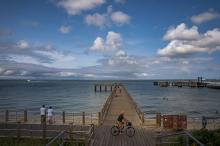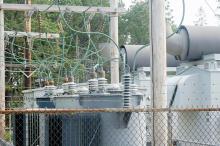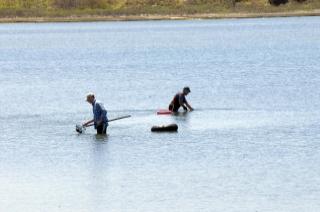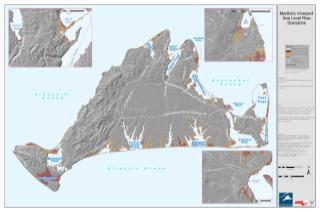
Climate change
2011
With sea level rise at our doorstep and storms chomping away at the shoreline it’s time to rethink an economy based largely on seasonal, coastal recreation. Why? Because as Ginny Jones, a lifelong Islander from a farming family muses so succinctly, “We can’t eat tourists.”
Clam chowder, bay scallops, fried oysters. Wampum bracelets. Shellfish are the grand bounty of the soft, sparkling salt ponds that ring the Island shore. We’d be hard pressed to find a local cultural symbol more significant than the water-worn purple and white quahaug shell. Purple — the Island color.
One day last month close to five inches of rain fell on Martha’s Vineyard. In Chilmark alone it caused a five-foot wide, four-foot deep sinkhole on State Road, the collapse of a two culverts and the dirt road to Lucy Vincent Beach, the collapse of an old granite bridge and the closure of South Road near the Allen Farm due to an impassable puddle.
Suddenly it’s flooding everywhere, all over the world — and it’s no fluke.
Climate change is complicated; sea level rise is not. We live on an Island — a glorified sandbar — and the sea is closing in on us. It is rising much faster than anticipated. In the last century sea level rose by about a foot. In this century, due to human-induced global warming, it is expected to rise at least five feet, according to a new report by the international Arctic Monitoring and Assessment Program.
That well-worn phrase — climate change. We know it’s out there, hovering over our lives like a heavy cloud. But what does it mean exactly — to you and the Island of Martha’s Vineyard?
It means striking changes in the three most critical components of Island life:
• The natural environment — the air, land and water;
• Our physical well being — our human health;
• The local economy.
2010
Of all the various experts gathered to speak about global warming and sea level rise at last Friday’s Living on the Edge conference on Nantucket, Franklin W. Nutter, president of the Reinsurance Association of America, delivered perhaps the most disturbing message.
His insight was not related to the phenomenon itself so much as to the chances of a meaningful and concerted response. It was about politics and psychology more than environmental science.









